Polaris Australis (Sigma Octantis) is the current South Star, the nearest visible star to the south celestial pole. It is a yellow giant located 294 light-years away in the faint southern constellation Octans. Shining at magnitude 5.47, Polaris Australis is barely visible and not as useful in navigation as its northern counterpart, Polaris (the North Star) in the constellation Ursa Minor.
The star is circumpolar in the southern hemisphere, but never appears above the horizon for observers north of the equator. It is part of a trapezoid asterism that helps observers pinpoint the location of the south celestial pole.
Star type
Sigma Octantis is a yellow giant star of the spectral type F0 III. It has a mass of 1.59 solar masses and a radius 4.32 times that of the Sun. It is 43 times more luminous than the Sun, with an effective surface temperature of about 7,415 K. The star is a fast spinner, with a projected rotational velocity of 145 km/s. Its estimated age is 912 million years.
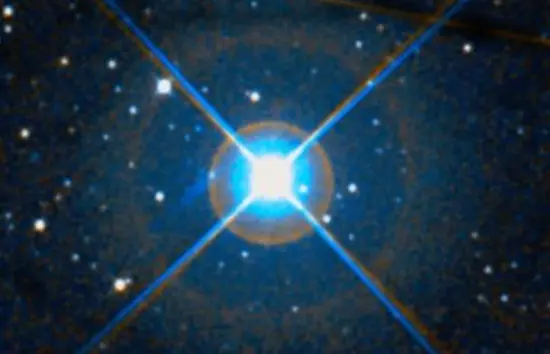
The South Star – Sigma Octantis (Polaris Australis), image: Wikisky
The South Star is classified as a Delta Scuti variable. It has an average apparent magnitude of 5.47 and its brightness varies by 0.03 magnitudes over a period of 2.33 hours.
Delta Scuti variables are young stars that that exhibit variations in brightness because of both radial and non-radial pulsations. As they swell and shrink, their luminosity changes. The stars have a period-luminosity relation and are used as standard candles for measuring galactic and extragalactic distances. The best-known Delta Scuti variables in the sky are the prototype Delta Scuti in the constellation Scutum, Altair in Aquila, Caph in Cassiopeia, and Seginus in Boötes. Vega in Lyra and Denebola in Leo may also belong to this group.
South Star
Polaris Australis is the nearest visible star to the south celestial pole. It lies a little over a degree from the south celestial pole. The pole is currently moving away from the star due to the Earth’s axial precession.
The current South Star is not very useful in navigation because, at magnitude 5.47, it is invisible from light-polluted areas and quite faint even in the best of conditions. Instead, observers commonly use the stars of the bright Southern Cross to find true south.
Sigma Octantis has not always been the South Star nor will it keep the title forever. It is one of several stars that take their turn as the southern pole star. Around the year 200 BCE, the yellow subgiant Beta Hydri in the neighbouring constellation Hydrus was the nearest star to the pole. Shining at magnitude 2.8, it was a more useful marker of true south. Around 3400 BCE, the bright Achernar in Eridanus came within 7.5 degrees of the south celestial pole.
The stars that will serve as South Stars in the future include Gamma Chamaeleontis (4200 CE), I Carinae and Omega Carinae (5800 CE), Upsilon Carinae and Aspidiske (Iota Carinae, 8100 CE), and Alsephina (Delta Velorum, 9200 CE). Aspidiske and Alsephina are part of the False Cross, an asterism commonly mistaken for the Southern Cross, which points in the general direction of the pole.
Around 14,000 CE, the bright Canopus will come within 8 degrees of the pole and, in the year 66270 CE, proper motion will take Sirius, currently the brightest star in the sky, within 2.5 degrees of the pole.
Facts
Sigma Octantis is only the 14th brightest star in the constellation Octans. Octans itself is very faint. Its brightest star, the orange giant Nu Octantis, shines at magnitude 3.73 and does not make the list of the 300 brightest stars in the sky.
As the southern pole star, Sigma Octantis always appears in the same place in the sky from any location in the southern hemisphere, and other stars appear to circle around it.
The variable red giant BQ Octantis appears even closer to the pole than Polaris Australis – less than a quarter of a degree away – but at magnitude 6.8, it is below the limit of unaided eye visibility.
Name
The name Polaris Australis (pronunciation: (/poʊˈlɛərɪs ɔːˈstreɪlɪs/) refers to the star’s role as the southern pole star. The name has been used since the 1700s. It was approved by the International Astronomical Union’s (IAU) Working Group on Star Names (WGSN) on September 5, 2017.
Sigma Octantis is the only named star in the constellation Octans. It is the southernmost star with a formal name.
Location
Polaris Australis lies in the constellation Octans, in a region of the sky that does not have any particularly bright stars or recognizable asterisms. The main constellation figure of Octans, a triangle formed by Nu, Beta and Delta Octantis, lies about halfway between the Southern Pointers – Alpha and Beta Centauri – and the bright Achernar in the constellation Eridanus.
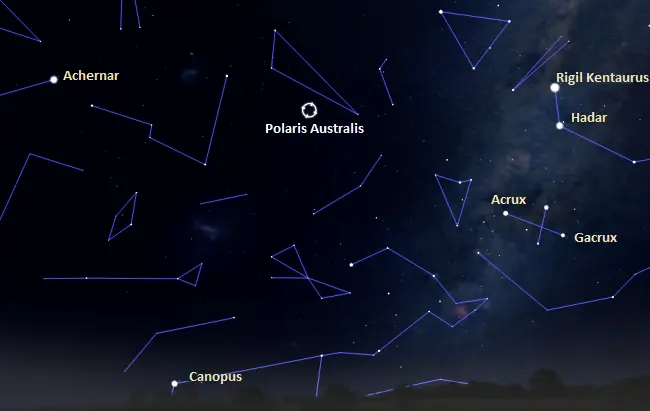
The location of Sigma Octantis (Polaris Australis), image: Stellarium
Sigma Octantis appears outside the triangle pattern, near the line connecting Beta and Delta Octantis. It is part of a trapezoid asterism also formed by Chi, Tau, and Upsilon Octantis.
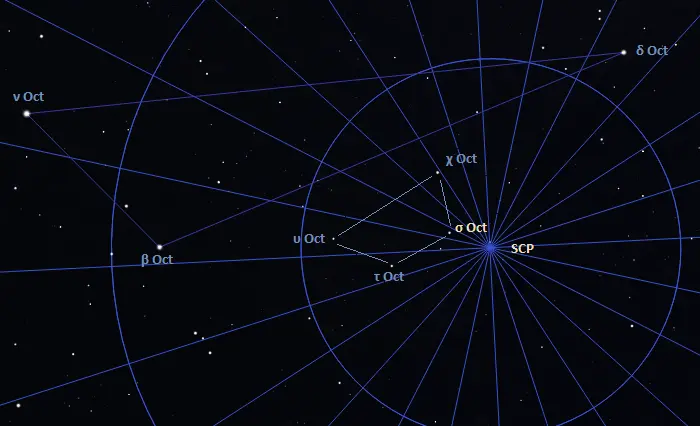
The South Star and the south celestial pole, image: Stellarium
How to find the south celestial pole
Since the South Star is too faint to be used as a marker of true south, there are other ways to find the south celestial pole. These involve using some of the brightest stars in the sky.
These methods are only used for determining the approximate position of the pole. To pinpoint its exact location, observers need to find the trapezoid formed by Sigma Octantis with the other three faint Octans stars.
The first method is to use the bright stars of the Southern Cross and the Southern Pointers, Alpha and Beta Centauri. The pole lies near the intersection of two imaginary lines: one extended from Gacrux through Acrux in the Southern Cross and another drawn perpendicular to the line connecting Rigil Kentaurus and Hadar (Alpha and Beta Centauri). The intersection of the two lines appears 5-6 degrees from the pole. Alternatively, the pole is found about halfway along the imaginary line connecting Achernar with the midpoint of the line drawn between Hadar and Mimosa.
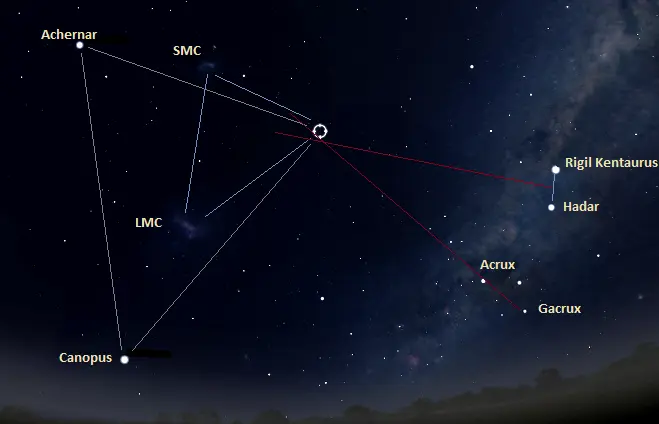
The location of the south celestial pole, image: Stellarium
The second method involves using the two brightest stars in the sky, Sirius and Canopus. A line drawn from Sirius through Canopus and extended by the same distance as that between the two stars leads to a point within a few degrees of the south celestial pole.
Canopus can also be used with Achernar to locate the pole. The two stars form a large equilateral triangle with the pole.
The final method can be used on clear, dark nights, when the Large and Small Magellanic Clouds are visible to the unaided eye. The two Milky Way satellites form a smaller equilateral triangle with the pole.
Constellation
The South Star is located in the constellation Octans. Octans is one of the small, faint southern constellations created by French astronomer Nicolas-Louis de Lacaille in the 1750s. Lacaille named the constellation after the octant, a measuring instrument used in navigation. The Latin word octans means “eighth part of a circle,” which describes the arc of the navigational instrument.
The brightest star in Octans, Nu Octantis, is an orange giant located 63.3 light years away. All but one of the 10 brightest stars in Octans are giants. Beta Octantis, the constellation’s second brightest star, is the only one that has yet to evolve into one. It has the stellar classification A9IV-V, indicating that it, too, may have come to an end of its main sequence lifetime. Other notable stars in Octans include the class K giants Delta Octantis and Theta Octantis, the semiregular variable red giant Epsilon Octantis, the binary system Alpha Octantis, consisting of two F-class giants, and the G-type giant Gamma1 Octantis.
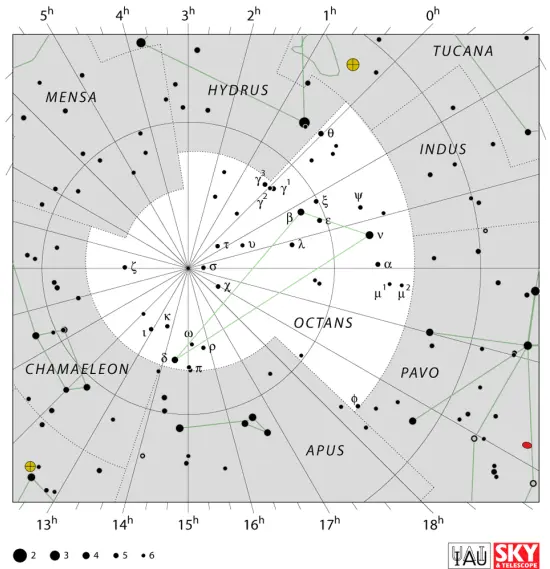
Octans constellation map by IAU and Sky&Telescope magazine
Octans also contains several stars known to host exoplanets: Mu2 Octantis, HD 142022, and HD 212302. All three are binary stars. Planets have been detected orbiting the primary components.
Octans is home to several notable deep sky objects. These include the barred spiral galaxy Polarissima Australis (NGC 2573), the nearest NGC object to the south celestial pole, the barred spiral galaxies NGC 7095 and NGC 7098, and the magnitude 5.3 open cluster Collinder 411.
The best time of year to observe the stars and deep sky objects in Octans is during the month of October, when the constellation is high in the evening sky. The entire constellation is visible from locations between the latitudes 0° and 90° S. Most of the constellation never rises for observers north of the equator.
The 10 brightest stars in Octans are Nu Octantis (mag. 3.73), Beta Octantis (mag. 4.13), Delta Octantis (mag. 4.31), Theta Octantis (mag. 4.78), Epsilon Octantis (mag. 5.09), Gamma1 Octantis (mag. 5.10), Alpha Octantis (mag. 5.13), Lambda Octantis (mag. 5.27), Gamma3 Octantis (mag. 5.283), and Chi Octantis (mag. 5.28).
Polaris Australis – Sigma Octantis
| Spectral class | F0 III |
| Variable type | Delta Scuti |
| U-B colour index | +0.13 |
| B-V colour index | +0.26 |
| Apparent magnitude | 5.47 |
| Absolute magnitude | 0.86 ± 0.09 |
| Distance | 294 ± 2 light-years (90.1 ± 0.5 parsecs) |
| Parallax | 11.1005 ± 0.0616 mas |
| Radial velocity | +11.9 ± 2 km/s |
| Proper motion | RA: +26.323 ± 0.071 mas/yr |
| Dec.: +4.721 ± 0.74 mas/yr | |
| Mass | 1.59 M☉ |
| Luminosity | 43 L☉ |
| Radius | 4.32 R☉ |
| Temperature | 7,415 ± 252 K |
| Age | 912 million years |
| Rotational velocity | 145 km/s |
| Surface gravity | 3.71 cgs |
| Constellation | Octans |
| Right ascension | 21h 08m 46.8635702002s |
| Declination | −88° 57′ 23.398330581″ |
| Names and designations | Polaris Australis, Sigma Octantis, σ Oct, South Star, HD 177482, HR 7228, HIP 104382, SAO 258857, CPD−89°47, FK5 923, GC 28194, GCRV 12662, PPM 378539, UBV 16180, IRAS 20151-8908, 2MASS J21084697-8857236, TYC 9536-384-1, Gaia DR2 6341181494973204096, Gaia EDR3 6341181494973204096 |